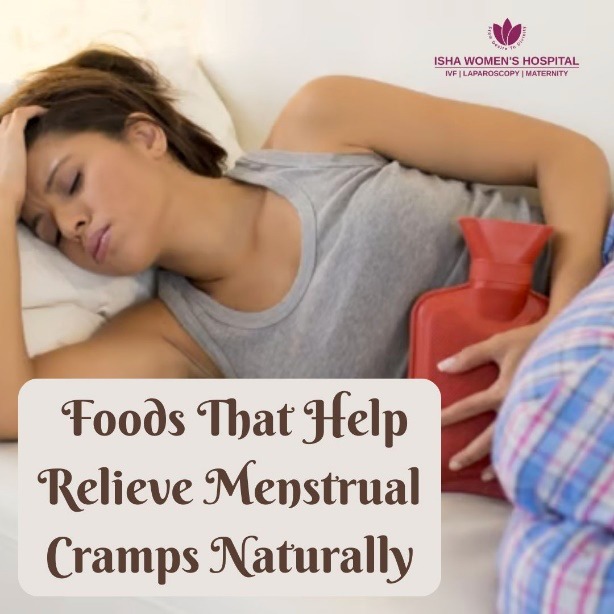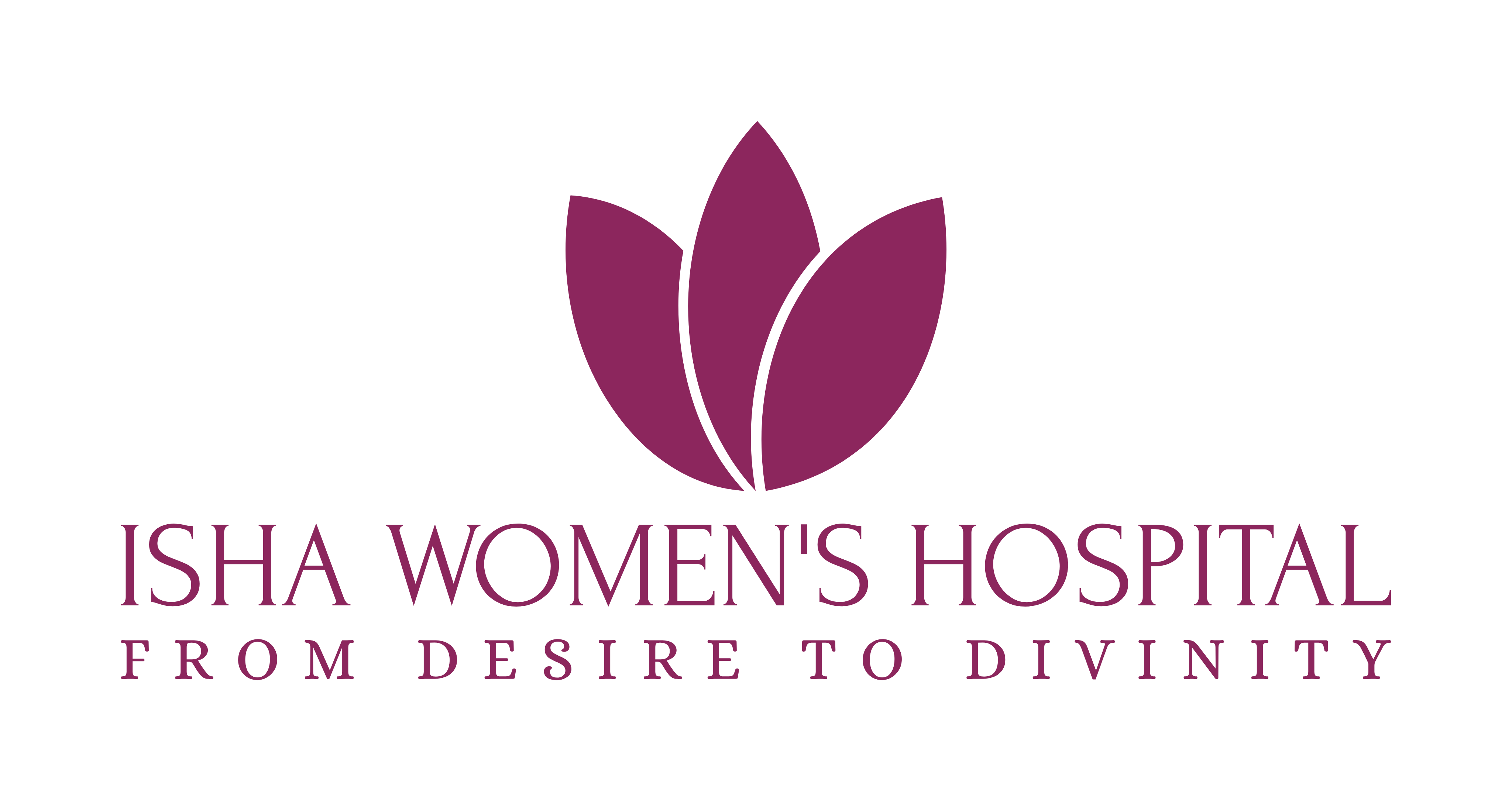Foods That Help Relieve Menstrual Cramps Naturally

At Dr. Chinmay Pataki’s Isha Women’s Hospital, the leading fertility centre in Dombivli, we understand how challenging menstrual symptoms can be. That’s why we offer a holistic approach to care, combining expert nutritional guidance with proven methods to help ease your discomfort. Discover how the right foods can relax uterine muscles, reduce inflammation, and balance hormones, making your periods more manageable, naturally. Trust us to help you live pain-free every month.
In this blog, brought to you by
Why Diet Matters During Your Period
Let’s break down why food choices matter so much during your menstrual cycle:
What Causes Menstrual Cramps?
1. Uterine Contractions and Prostaglandins
The primary cause of menstrual cramps is uterine contractions, which occur as the uterus works to shed its lining. The lining of the uterus (endometrium) builds up throughout the menstrual cycle in preparation for pregnancy. If pregnancy does not occur, the body sheds this lining, leading to menstruation.
- During this process, the uterus contracts to expel the shedding tissue, and these contractions are triggered by prostaglandins—hormone-like substances that are produced in the lining of the uterus.
- High levels of prostaglandins lead to stronger, more intense contractions, which in turn result in more pain and cramping. Prostaglandins also cause inflammation, making the pain even more severe.
- The stronger the uterine contractions, the less blood and oxygen reach the uterine muscle, leading to pain, discomfort, and cramping.
As the uterus contracts, blood vessels in the uterine lining are compressed, restricting the blood flow and causing oxygen deprivation. This lack of oxygen in the uterine muscles leads to the sensation of pain and discomfort. The body responds by triggering more contractions to help shed the lining, perpetuating the pain cycle.
3. Hormonal Imbalances
Hormonal imbalances, particularly involving estrogen and progesterone, can also contribute to the intensity of menstrual cramps. High levels of estrogen can increase the production of prostaglandins, leading to more severe contractions. Low levels of progesterone, which is responsible for maintaining the uterine lining during the second half of the cycle, can lead to excessive shedding and inflammation, both of which can worsen cramps.
- Conditions like Polycystic Ovary Syndrome (PCOS), and other conditions that cause hormonal imbalances may increase the severity of menstrual cramps.
How Nutrition Affects Your Menstrual Cycle
A balanced diet that includes healthy fats, protein, vitamins, and minerals is essential for maintaining hormonal equilibrium. For example:
- Magnesium-Rich Foods: Magnesium helps relax the muscles, including the smooth muscles of the uterus. It also plays a role in reducing prostaglandin levels. Low magnesium levels have been linked to more severe cramps.
- Best sources: Spinach, almonds, bananas, and pumpkin seeds
- Omega-3 Fatty Acids: Omega-3s are powerful anti-inflammatory agents. They help lower the production of inflammatory prostaglandins and reduce the intensity of menstrual pain.
- Best sources: Fatty fish like salmon, flaxseeds, chia seeds, walnuts
- Fibre: Fibre helps the body eliminate excess estrogen. High estrogen levels during the luteal phase (just before menstruation) can make symptoms like bloating and breast tenderness worse. A fibre-rich diet helps in hormonal balance and improves digestion, reducing period discomfort.
- Best sources: Whole grains, fruits, vegetables, legumes
- Antioxidants: Antioxidants fight oxidative stress and inflammation in the body. They support tissue repair and ease pain associated with uterine inflammation.
- Best sources: Berries, dark chocolate, green leafy vegetables, turmeric
Poor Dietary Choices Can Make It Worse
- Increasing inflammation
- Causing bloating and water retention
- Disrupting blood sugar levels, which can trigger mood swings
- Contributing to hormonal imbalances, especially involving estrogen and progesterone
By incorporating foods rich in vitamins, minerals, antioxidants, and healthy fats, you can naturally support your body and make your menstrual cycle smoother and less painful. If you're struggling with menstrual pain, hormonal imbalances, or irregular cycles, Isha Women’s Hospital can guide you with a personalized, holistic approach to fertility and menstrual health.
Top Foods That Help Relieve Menstrual Cramps Naturally
Leafy Greens (Spinach, Kale, Swiss Chard)
These vibrant greens are nutritional powerhouses, especially during menstruation.
- Rich in magnesium: Magnesium helps relax the uterus and reduce the severity of cramps by decreasing prostaglandin levels.
- High in iron: Menstrual bleeding can lead to a drop in iron levels, causing fatigue and weakness. Leafy greens help replenish lost iron.
- Also contains calcium and fibre, which support muscle function and hormone balance.
Fatty Fish (Salmon, Sardines, Mackerel)
Fatty fish are some of the best anti-cramp foods thanks to their omega-3 content.
- Loaded with omega-3 fatty acids: These healthy fats help reduce the production of prostaglandins, which are responsible for uterine contractions and inflammation.
- Omega-3s also improve blood circulation and reduce overall pain.
- They promote hormonal balance and boost mood, which is often low during menstruation.
Bananas, Berries & Oranges
These fruits offer a delicious way to fight cramps and support your reproductive health.
- Bananas: Rich in potassium and vitamin B6, they help prevent water retention, bloating, and support muscle relaxation.
- Berries: Strawberries, blueberries, and raspberries are full of antioxidants that help fight inflammation and oxidative stress.
- Oranges: Packed with vitamin C and calcium, oranges help in muscle function and also improve iron absorption, essential during your period.
Ginger & Turmeric
These warming spices are some of the most effective natural remedies for menstrual cramps.
- Ginger: Contains compounds like gingerol that have strong anti-inflammatory and pain-relieving effects. It also reduces nausea and soothes digestive issues, which often accompany menstruation.
- Turmeric: Curcumin, the active compound in turmeric, has been shown to reduce prostaglandin levels, thereby easing cramps.
Nuts & Seeds (Flaxseeds, Almonds, Walnuts)
Small but mighty, nuts and seeds are packed with nutrients that support menstrual comfort.
- Flaxseeds: Contain phytoestrogens and omega-3s that help regulate hormone levels and reduce inflammation.
- Almonds and walnuts are excellent sources of magnesium, vitamin E, and healthy fats, all of which help ease cramps, reduce breast tenderness, and improve mood swings.
Dark Chocolate (70% or more)
Good news for chocolate lovers! Dark chocolate is not only comforting but also beneficial during periods.
- Rich in magnesium, which helps relax uterine muscles and ease cramps.
- Contains antioxidants that reduce inflammation and support overall cell health.
- Also boosts serotonin levels, helping you feel calmer and more balanced during PMS.
These nutrient-rich foods not only help alleviate cramps but also improve your energy levels, mood, digestion, and hormonal balance during your menstrual cycle. Including them regularly, not just during your period, can have long-term benefits for your reproductive health.
Foods & Habits to Avoid During Periods
Foods That Worsen Cramps
Not all foods are your friend during your period. Some can trigger or intensify cramps, increase bloating, and throw your hormones off balance.
- Caffeine - Narrowing blood vessels and increasing tension can worsen cramps and disrupt sleep.
- Processed Foods - Loaded with sodium and added sugars, leading to bloating, water retention, and inflammation.
- Red Meat - High in arachidonic acid and prostaglandins, which can increase uterine contractions.
- Alcohol - Causes dehydration, fatigue, and worsens mood swings and menstrual headaches.
Tips to Support a Cramp-Free Cycle Naturally
- Stay hydrated: Drinking plenty of water helps reduce bloating and keeps your body functioning smoothly. Add herbal teas like chamomile, peppermint, or ginger for added relief.
- Eat small, frequent meals: This stabilises your blood sugar and keeps energy levels consistent, helping avoid cravings and mood swings.
- Exercise gently: Activities like walking, stretching, or yoga promote better blood circulation and relax your pelvic muscles, reducing cramp intensity.
- Apply heat: Use a heating pad, warm compress, or take a hot bath to soothe muscle contractions and ease abdominal pain.
- Manage stress: Period pain can worsen with stress. Practice deep breathing, meditation, yoga, or simply take time for self-care.
Let Food Be Your Natural Period Relief
Every bite you take can either nourish your hormones or disrupt them. By embracing a diet rich in leafy greens, omega-3 fats, antioxidants, and anti-inflammatory herbs, you’re not just reducing cramps—you’re honoring your body, supporting your fertility, and paving the way for long-term reproductive health.
Menstrual cramps are common, but they don’t have to be unbearable. By making conscious food choices and embracing gentle lifestyle changes, you can naturally support your body during your cycle.
- Let food be your medicine: A nutrient-rich, anti-inflammatory diet can work wonders in reducing period pain and boosting your energy.
- Include healing foods daily: Leafy greens, berries, nuts, turmeric, and healthy fats aren’t just good during your period—they’re great for your overall hormonal health.
- Avoid processed junk: Sugary, salty, and highly processed foods can worsen cramps and mood swings. Swap them for wholesome, fresh alternatives.
At Isha Women’s Hospital, we understand the deep connection between nutrition, hormones, and menstrual well-being. Led by Dr. Chinmay Pataki, the best fertility consultant and gynecologist in Thane, our team offers compassionate care that combines modern science with holistic healing. Whether you're struggling with painful periods, irregular cycles, or fertility issues, we’re here to guide you with personalized solutions that work from the root.
You deserve a life where your cycle feels natural—not painful. Start by making small, nourishing changes—and if you need expert support, reach out to Isha Women’s Hospital, the best IVF and women’s health center in Thane, for tailored hormonal and nutritional guidance.
Frequently Asked Questions (FAQS)
Ans - Yes—anti-inflammatory and mineral-rich foods relax muscles and reduce pain.
2. Should I avoid caffeine during my period?
Ans - Yes—caffeine can worsen cramps and dehydration.
3. How soon before my period should I start eating these foods?
Ans - Ideally, a few days before and during your period for best results.
4. Does chocolate help with cramps?
Ans - Dark chocolate with magnesium helps relax muscles and lift mood.
5. Are supplements necessary if I eat these foods?
Ans - Not always—whole foods are best, but supplements can fill gaps if needed.
